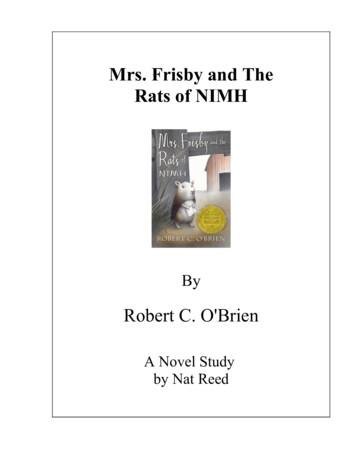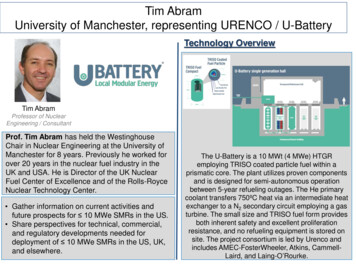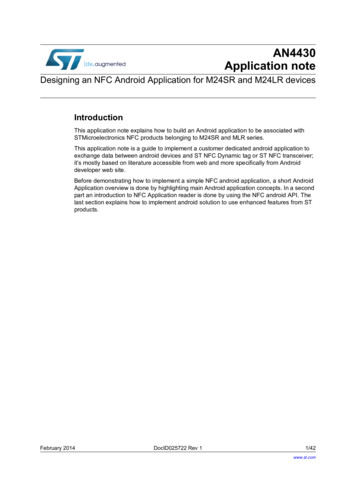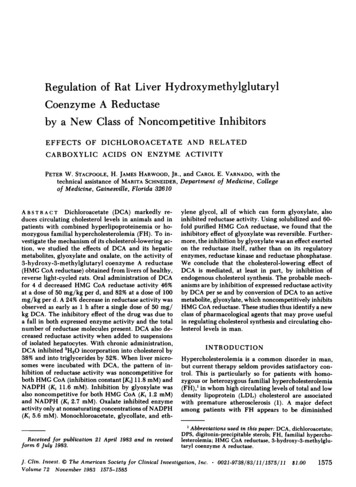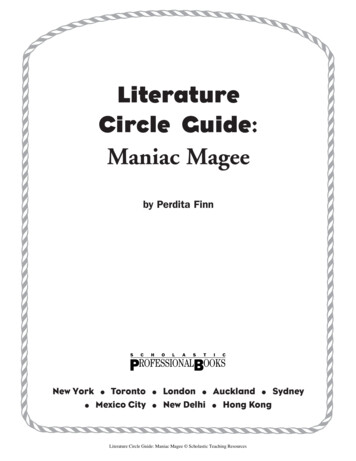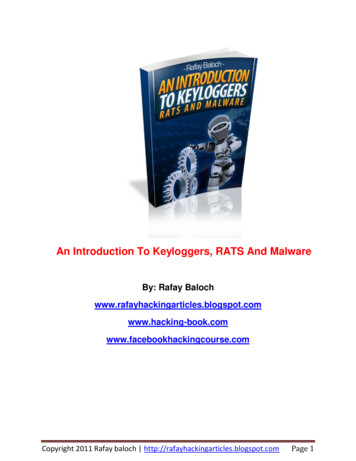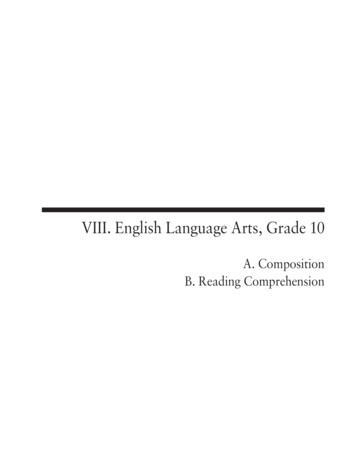
Transcription
Harvey1Katelin HarveyLiteracy BlockProfessor SchillingApril 18, 2006Mrs. Frisby and the Rats of NIMH: A 5th Grade Literacy Focus Unitcreated byKatelin HarveyFEATURED SELECTIONMrs. Frisby and the Rats of NIMH by Robert C. O’Brien. New York: Atheneum, 1971.Written at a fifth grade level, Robert C. O’Brien’s Newbery Award book Mrs. Frisby and theRats of NIMH is the story of Mrs. Frisby, who is a widowed mouse, and her four young childrenwho live on the Fitzgibbon family farm. Every year the mouse family must move to a summershelter because their winter home gets destroyed by plowing. However, this year they mustmove earlier than normal because of an early thaw; however, this is not good because Mrs.Frisby’s youngest son, Timothy, is deathly sick and can not be moved. She goes in search ofassistance and visits her friend, Mr. Ages, gets medicine for Timothy, and on her way back shesaves a crow named Jeremy, from the farmer’s cat. Jeremy takes her to a very wise owl and hetells her to seek the help of a group of rats who lives under a rose bush in the woods. When shemeets them she finds out that they were rats that had been experimented on in the NIMHlaboratories and have human level intelligence. Mrs. Frisby also found out that her late husband,Jonathan, had been experimented on as well and was a friend of the rats, and so they agree tohelp come up with a solution to her problem.RELATED MATERIALSRacso and the Rats of NIMH by Jane Leslie Conly. New York: Harper & Row, 1986.This is a direct sequel to Mrs. Frisby and the Rats of NIMH, and is written at a fourthgrade reading level, and written by the daughter of Robert C. O’Brien, Jane Leslie Conly.Mrs. Frisby's children visit the Rats of NIMH themselves when they are older andsolidify many questions that the other book left unexplained.Runaway Ralph by Beverly Cleary. New York: William Morrow and Company, 1970.Written at a fifth grade reading level, this story is about a mouse named Ralph, who liveswith his family in a hotel, gets fed up with his family, and gets on his toy motorcycle andgoes down the road to a summer camp. This book relates to the Rats of NIMH, becauseRalph, a mouse, gets himself into many tough situations, just like Mrs. Frisby.
Harvey2Redwall by Brian Jacques. New York: Avon Books, 1986.Written at a fifth grade reading level, this book, the first in a series, is about a mousenamed Matthias and his adventures searching for weapons of the legendary mousewarrior, Martin. This book ties in well with Mrs. Frisby and the Rats of NIMH because italso deals with rats and mice that have human like qualities.Owls: Animal Predators by Sandra Markle. Minneapolis: Lerner, 2004.This book is written at a fifth grade level and is a non fiction book about owls and givesdetailed information about the habitat and way of life of owls. This book ties in withMrs. Frisby and the rats of NIMH because one of the characters is an owl, and thestudents will use this book as a reference for when we talk about owl habitats.Rats by Sandy E. Powell. Minneapolis: Lerner, 1994.This book is written at a fourth grade level and is a non fiction book about rats anddescribes their habits, characteristics, and life cycle. This books links well with Mrs.Frisby and the Rats of NIMH because it gives factual information about rats.The Book of North American Owls by Helen Roney Sattler. New York: Clarion Books,1995This book is written at a fifth grade reading level and is a non fiction book about owls inNorth America and offers another look into their habitat and different species of owls.This ties in again with Mrs. Frisby and the Rats of NIMH because of the owl present inthe text.GOALS·····Students will study the various characters in the book, focusing heavily on Mrs.Frisby and her bravery when faced with the danger of losing her family.Students will gain a better understanding of the behavior and habitats of owls bycomparing and contrasting real owls to the character in the book.Students will gain a better understanding of the behavior and habitats of rats bycomparing and contrasting real rats to the characters in the book.Students will examine the different types of conflict that take place within the book.Students will practice making connections, such as text to text, text to self, and text to world while reading.STRAGETIES····I will teach predicting and visualizing.I will teach about how to make inferences when reading.I will teach about personification and how it is used in the text.I will teach about the different types of conflicts.
Harvey·3I will teach about making connections, such as text to text, text to self, and text to world.STATE STANDARDSEnglish:5.2.3 Recognize main ideas presented in texts, identifying and assessing evidence that supportsthose ideas.5.2.4 Draw inferences, conclusions, or generalizations about text and support them with textualevidence and prior knowledge.5.3.2 Identify the main problem or conflict of the plot and explain how it is resolved.5.3.3 Contrast the actions, motives, and appearances of characters in a work of fiction anddiscuss the importance of the contrasts to the plot or theme.Science:5.4.7 Explain that living things, such as plants and animals, differ in their characteristics, andthat sometimes these differences can give members of these groups (plants and animals)an advantage in surviving and reproducing.UNIT PLANPre readingActivity:o The teacher will have a speaker, or naturalist, come in and show thestudents different types of owls and rats. The students will be able totouch and see the animals they are going to be reading about in the book.Grouping: Whole groupo They will write a quickwrite about what they learned about rats and owls.Grouping: Individualo The teacher will give a book talk about Mrs. Frisby and the Rats of NIMHand the students will do a K W L chart.Grouping: Whole group, individualReadingActivity:o Teacher will read the first chapter of the novel aloud to the class. Whilereading aloud to the class, the teacher will stop periodically to discusswhat type of conflict is developing and what pictures are developing intheir minds about the setting and characters.Grouping: Whole groupo The students will start reading chapter two individually or with a buddyand whatever they do not finish is homework.Accommodations: For my struggling readers, I will have them read with abuddy who is a stronger reader so that they can help them while they arereading. I will also work with the student myself during individualreading making sure they are staying on task and helping them with anyquestions. I will also use the resources available to me through the school,such as resource teachers, aids, or parent volunteers to help the studentduring reading time.
Harvey4Grouping: Individual and Buddy ReadingRespondingActivity:o While reading the book, students will write in their response journals atleast two times each week. One topic will include “In what ways has Mrs.Frisby shown her bravery so far, and if you were in a similar situationwould you be able to do the same? Why?”o The students will also write in their journals about various predictions theyhave of what they think will happen next in the story.o They can also make connections and discuss the various elements ofconflict they see developing and changing.Grouping: IndividualExploringWord wall words to add: admonished, antidote, astute, baffled, brisk, captivity,consternation, contritely, cryptic, dubiously, entranced, futile, incredulously,meekly, protruding, snared, skeptical, tedious, thrived, urgency, and ventilation.Activity:o The students will discuss with each other in class what they think themeaning of various quotes are, such as “All doors are difficult to openuntil you find the key,” and “The size of the brain is no measure of itscapacity.”Grouping: Partnerso The teacher will introduce personification by discussing its meaning andhow it is used in the text. In the story the animals take on humancharacteristics, such as attitudes and feelings.o Using a Venn Diagram, each student will compare and contrast thebehavior of rats and owls in the book to the behavior of rats and owls innature.Grouping: IndividualApplyingActivity: Choose one of the following:o The students may design and then make a model of Mrs. Frisby’s home. Itneeds to be three dimensional and have many details that were used todescribe what it looked like in the book.Grouping: Individual, small groupo The students may choose a section from the book and then create a skitand act it out for the class. They can use costumes and scenery if they sochoose.Grouping: Small group, whole groupo The students may write a cinquain poem describing a character and thencan illustrate their poem.http://hrsbstaff.ednet.ns.ca/davidc/6c files/Poem%20pics/cinquaindescrip.htmGrouping: Individual
Harvey5o The students may debate animal rights and medical testing on animalssince the rats of NIMH were products of such activities.Grouping: Whole group, small groupTIME SCHEDULEMondayDay 1:! Have guestspeaker/naturalist come inand showstudents realrats and owls! Quickwrite! Introduce thebook! Read chapter1 out loud/KWL chart! Students startreading chpt2 3 in class,finish forhomework(40 min.)Day 6:! The teacherwill readaloud chpt.12! Compare andcontrastusing Venndiagram therats and owlsin real life tothe charactersin the book! Start readingchpt. 13,finish forhomework(25 min.)TuesdayDay 2:! Classdiscussionover chpt 2 3! Students writein theirjournals! Teacherintroducesconflict! Teacher readschpt 4! Students startchpt 5 6,finish forhomework(35 min.)WednesdayDay 3:! During classdiscussionover chpt 5 6teacher willdiscuss thepredictingstrategy! Students willwrite in theirjournals theirpredictions! Students willbuddy readchpt 7 in class(25 30 min.)ThursdayDay 4:! Studentsreadchapters 8 inindividual orbuddyreading! Teacherintroducesrelatedmaterials! Studentswill readchpt. 9 10forhomework(20 25 min.)FridayDay 5:! Studentsread chapter11 buddyreading! Students willwrite in theirjournalsmakingconnections! Participatein grandconversationin classdiscussion(25 min.)Day 7:! Discuss ingrandconversationchpt 13! Teachminilesson onword wallwords! Students writein journals! Start readingchpt 14, finishfor homework(25 min.)Day 8:! Students readchapters 15 inbuddy reading! Teacherdiscusses thepredictingstrategy! Students startreading chpt16, finish forhomework(25 30 min.)Day 9:! Studentsread chpt 17individual! Studentswrite injournals! Read chpt18 forhomework(20 25 min.)Day 10:! Discuss chpt18 in grandconversation! Teacherdiscusseshow to makeinferences! Teacherreads aloudchpt 19(25 min.)Continues to next page.
HarveyContinues tonext page.Day 11:! Students readchpt 20individually! Teacher willdiscusscharactersfocusing onhow Mrs.Frisby’scharacter hasdeveloped! Students willwrite injournals! chpt 21homework(20 min.)Day 16:! The teacherreadsepilogue! Grandconversation! Studentswrite injournals ifpredictionswere correct(30 min.)6Day 12:! Students readchpt 22 23with a buddy! Teacherdiscussesvisualizing! Finish chptsfor next day(20 min.)Day 13:! Grandconversationon chpt 22 23! Minilesson onpersoni fication! chpt 24 forhomework(25 min.)Day 14:! Studentsread chpt 25individuallyor buddy! Studentsjournal –makingpredictions! Start readingchpt 26,finish forhomework! (25 min.)Day 15:! Grandconversationon chpt 26focusing onquotes fromthe book! Studentsread chpt 27individually,finish forhomework(20 min.)Day 17:! Studentschooseprojects andbegin to planand start them(20 min.)Day 18:! Students workon projects(25 min.)Day 19:! Studentswork onfinishingprojects! What is notfinishedbecomeshomework(20 min.)Day 20:! Studentsshare theirprojects withthe rest ofthe class(25 30 min.)ASSIGNMENT CHECKLISTJournal entries during unitVenn DiagramKWL chartModel, Skit, poem, or debate
Harvey7Monitoring student learning:o The teacher will observe the students during reading, writing, and small group activities(such as grand conversations) and make anecdotal notes of who participated and howmuch, along with other observations.o The teacher will have conferences with students periodically throughout the unit to see ifthey are comprehending the text and how they are progressing with the assignments.o The teacher will develop and use a rubric to grade the students’ journal entries, VennDiagrams, KWL charts, and final projects.o The teacher will develop a checklist for students to keep track of assignments completed.The teacher will have a folder for each student to keep their assignments and checklists inso they know what they have completed. These folders will be turned in at the end of thefocus unit.Ideas for Focus Unit taken fromo http://www.proteacher.com/cgi bin/outsidesite.cgi?id 4701&external original http://www.proteacher.com/070099.shtml&title Mrs.%20Frisby%20and%20the%20Rats%20of%20NIMHo http://library.thinkquest.org/J002079F/o http://www.kyrene.org/schools/brisas/sunda/mrs frisby/home.htmo riculum guides/Language%20Arts/6%20curr%20final.pdfo http://www.greece.k12.ny.us/ath/library/mssbrc/
Racso and the Rats of NIMH by Jane Leslie Conly . New York: Harper & Row, 1986 . This is a di rect sequel to Mrs. Frisby and the Rats of NIMH , and is written at a fourth grade reading level, and written
